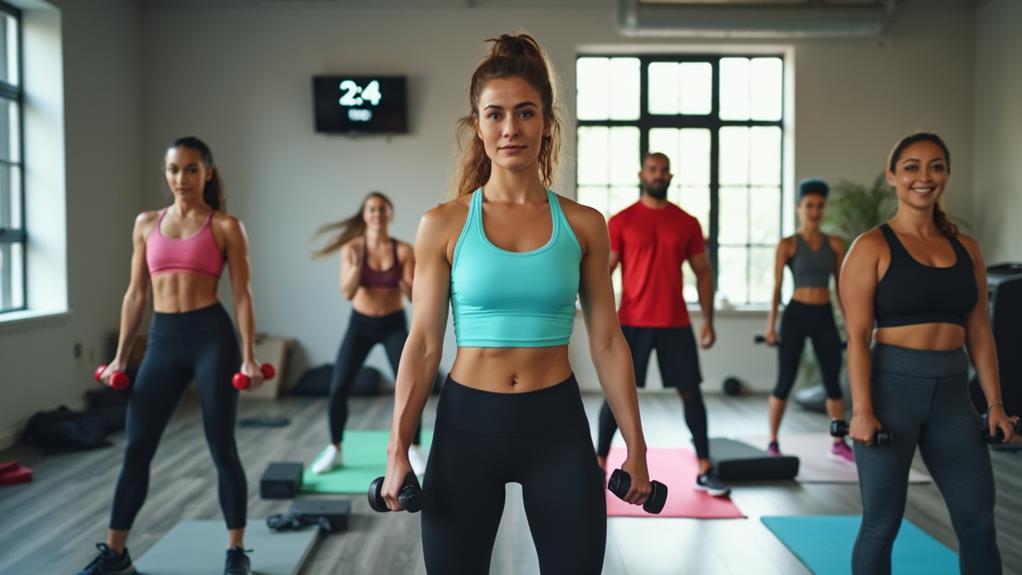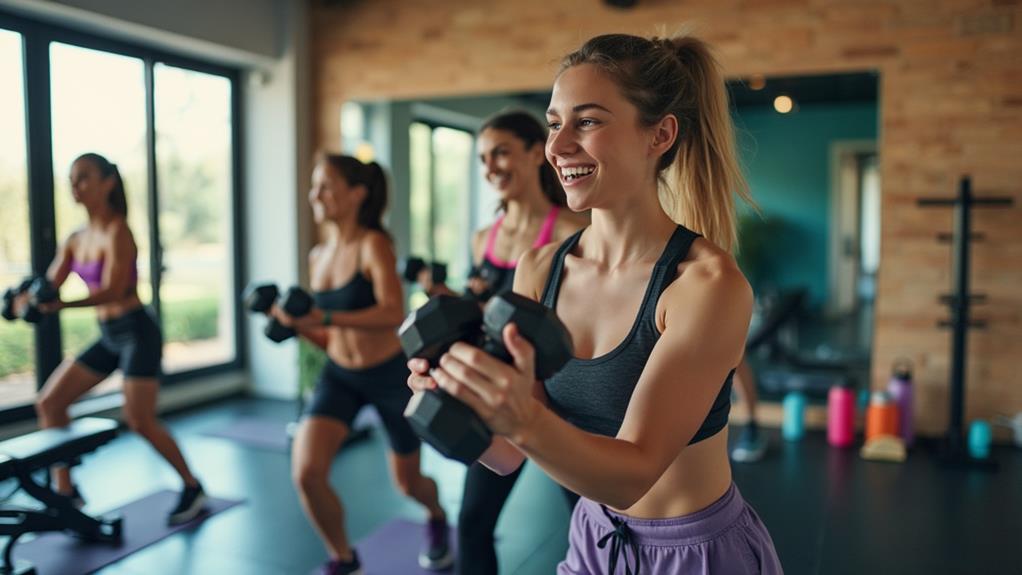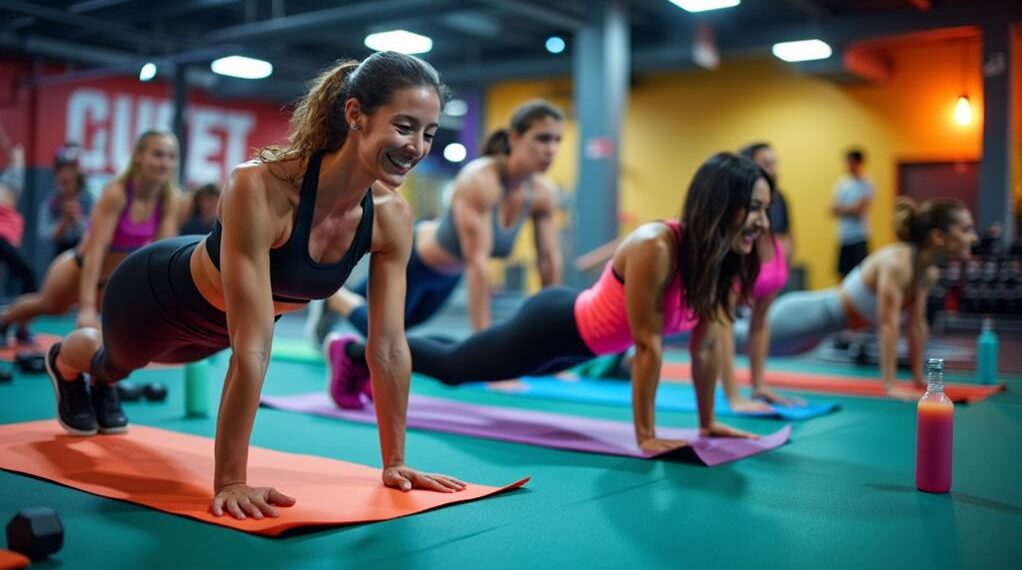Imagine trying to solve a complex puzzle with only a few pieces in hand; that's how starting a fitness journey can feel without the right plan. Quick workout plans offer a streamlined approach, perfect for newcomers who want effective results in a limited timeframe. These sessions can be the key to building a sustainable routine without overwhelming yourself. So, how do you choose the right type of workout to fit your busy lifestyle and guarantee you stay motivated? The answers might surprise you and set you on a path to success.
Benefits of Quick Workouts

Quick workouts offer numerous benefits that can easily fit into even the busiest schedules. When you're short on time, these efficient exercise sessions can help you maintain your fitness goals without overwhelming your day.
You'll find that time efficiency is one of the standout advantages; even a quick 15-30 minute workout can yield impressive results. Engaging in these rapid sessions not only saves time but also boosts your increased energy levels throughout the day.
You'll notice that a short burst of physical activity can elevate your mood and sharpen your focus, making it easier to tackle everyday tasks. Plus, with quick workouts, you're more likely to stick to a consistent routine, which is key to long-term success.
As you integrate these workouts into your life, you'll discover how they can enhance your overall well-being. You won't just feel stronger physically; you'll also experience mental clarity and emotional resilience.
Types of Quick Workout Plans
When you're looking to maximize your workout efficiency, knowing the types of quick workout plans available can make all the difference.
Here's a breakdown of some effective options that fit into even the busiest schedule:
- Circuit Training: This method combines strength and cardio exercises in a fast-paced routine, allowing you to work multiple muscle groups while keeping your heart rate up.
- Bodyweight Exercises: These workouts rely on your own body weight for resistance, making them versatile and easy to do anywhere. Think push-ups, squats, or planks!
- High-Intensity Interval Training (HIIT): Short bursts of intense activity followed by brief rest periods can torch calories and improve endurance in just 20 minutes.
- Tabata: A specific form of HIIT that involves 20 seconds of intense work followed by 10 seconds of rest, repeated for four minutes. It's a killer way to get a quick burn!
Each of these plans has its own advantages, so pick one that resonates with you and fits your goals.
You'll be amazed at how much you can accomplish in a short amount of time!
Sample 20-Minute Full-Body Routine

Ready to get your heart pumping and muscles working? This quick 20-minute full-body routine is perfect for you! You won't need much workout equipment—just a mat and some dumbbells or resistance bands if you have them.
Start with a 3-minute warm-up, like jumping jacks or high knees, to get your blood flowing. Then, plunge into a circuit of five exercises: squats, push-ups, lunges, planks, and mountain climbers. Spend 30 seconds on each exercise, followed by a 15-second rest. Repeat the circuit four times for a full-body blast!
If you're new to any of these movements, don't hesitate to use exercise modifications. For squats, try sitting back into a chair, or for push-ups, drop to your knees. These adjustments will help you maintain good form and build confidence.
Finish your routine with a 3-minute cool-down, stretching your major muscle groups. Remember, it's all about progress, not perfection. As you get comfortable, feel free to increase the intensity or try new exercises. You've got this!
High-Intensity Interval Training (HIIT)
If you're looking to elevate your workout intensity, High-Intensity Interval Training (HIIT) is an excellent choice. This training method alternates short bursts of intense exercise with recovery periods, maximizing your results in minimal time.
You might've heard some HIIT myths, like it's only for elite athletes or that you need fancy equipment. The truth is, HIIT techniques are accessible to everyone, regardless of fitness level.
Here are some quick tips to help you get started with HIIT:
- Choose Your Intervals: Start with 20 seconds of high-intensity work followed by 40 seconds of rest.
- Mix It Up: Incorporate various exercises—sprints, burpees, or jumping jacks—to keep it fun.
- Listen to Your Body: Don't push too hard at first; adjust the intensity to suit your fitness level.
- Stay Consistent: Aim for 2-3 HIIT sessions per week for the best results.
With HIIT, you'll burn more calories in a shorter time, boost your metabolism, and improve your cardiovascular health.
Strength Training Essentials for Beginners

Building strength lays a solid foundation for overall fitness and well-being. As a beginner, it's crucial to focus on the basics of strength training to maximize your results and minimize the risk of injury. Start by mastering proper form. Good technique not only helps you engage the right muscles but also protects your joints.
Consider working with a trainer or watching instructional videos to verify you're performing exercises correctly.
When it comes to equipment choices, you don't need a fully stocked gym to get started. Bodyweight exercises like push-ups, squats, and lunges can be incredibly effective. If you're ready to incorporate weights, start with dumbbells or resistance bands, which offer versatility and allow you to gradually increase resistance as you gain strength.
Aim for two to three strength training sessions each week, targeting all major muscle groups. Don't forget to warm up before and cool down after your workouts.
Flexibility and Stretching Exercises
Incorporating flexibility and stretching exercises into your fitness routine is essential for enhancing overall performance and preventing injuries. By focusing on dynamic stretches during your warm-up routines, you prepare your muscles for activity, while static stretches and yoga poses can help improve your flexibility goals during cool down techniques.
To get started, consider including these key exercises in your routine:
- Dynamic stretches: Try arm circles and leg swings to increase blood flow.
- Static stretches: Hold stretches like hamstring and quadriceps holds for 15-30 seconds post-workout.
- Yoga poses: Incorporate downward dog and pigeon pose to enhance flexibility and relaxation.
- Mobility drills: Add hip openers and ankle rolls to improve joint function.
Don't let stretching myths fool you—there's no need to stretch before every workout, but incorporating flexibility exercises consistently will yield long-term benefits.
Remember, achieving flexibility goals takes time and patience, so stay committed.
Tips for Staying Motivated

Staying motivated can be a game changer in your fitness journey, and it's essential for achieving your goals. One effective way to maintain motivation is through goal setting. Break your larger goals into smaller, achievable milestones that you can celebrate along the way. This not only makes your fitness journey more manageable but also provides regular boosts of motivation as you accomplish each milestone.
Another great strategy is to find accountability partners. Surrounding yourself with like-minded individuals can create a supportive environment that encourages you to stay on track. Whether it's a friend who joins you for workouts or a fitness group you participate in, having someone to share your progress with can make a significant difference.
Additionally, keep your workouts fun and varied to avoid burnout. Try new classes, outdoor activities, or different workout styles to keep things interesting.
Remember to reward yourself for your efforts, whether it's treating yourself to new workout gear or enjoying a relaxing day off. By implementing these tips, you'll find it easier to stay motivated and committed to your fitness journey.
How to Track Your Progress
Tracking your progress is essential for staying on the path to your fitness goals. By keeping an eye on your achievements and setbacks, you can adjust your goal setting and make informed decisions about your workouts.
Here are some effective ways to assess your progress:
- Keep a Workout Journal: Write down your workouts, weights lifted, and reps completed. This helps you see improvements over time.
- Take Photos: Snap pictures of yourself every few weeks. Visual evidence can be a powerful motivator and show changes you mightn't notice daily.
- Measure Your Body: Use a measuring tape to track changes in your waist, hips, and other areas. Numbers can reveal progress that the scale might not.
- Set Milestones: Break your main goal into smaller, achievable milestones. Celebrate these wins to stay motivated on your journey.
Conclusion
Incorporating quick workouts into your routine is like planting seeds for a healthier lifestyle; with consistent care, they'll flourish. You'll boost your energy, build strength, and improve your mood—all in just 15 to 30 minutes. Remember, every small effort counts, and sticking to your plan will lead to lasting results. So lace up those sneakers, embrace the journey, and watch yourself transform into the best version of you! Your fitness adventure is just beginning.













